light

Figure 1. The Spectrum of visible light.
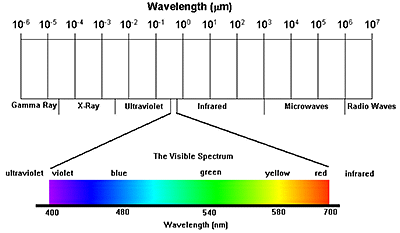
Figure 2. Visible light in relation to the whole electromegmetic spectrum.
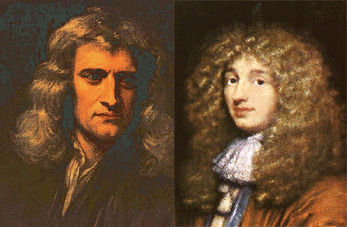
Figure 3. Isaac Newton (left) and Christiaan Huygens.
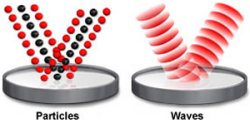
Figure 4. Reflection of light explained by both the particle and wave theories.
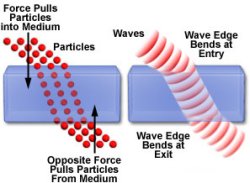
Figure 5. Refraction explained by particle and wave theories.
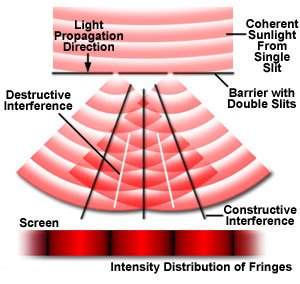
Figure 6. Thomas Young's double-slit experiment.
Light is a form of electromagnetic radiation that is visible to the human eye (Figures 1 and 2). Visible light occupies a narrow band of wavelengths in the electromagnetic spectrum between about 4 × 10–7 meter (red) to about 7 × 10–7 meter (violet). Beyond these wavelengths lie the infrared and ultraviolet regions, respectively. The term 'light' is sometimes used to describe radiation in other parts of the electromagnetic spectrum. We talk about 'infrared light' or 'ultraviolet light.'
Light can also behave as if it consists of a stream of tiny particles known as photons. This is puzzling and can only be resolved if we accept the wave-particle duality that is at the heart of quantum mechanics.
The speed of light in a vacuum is one of the most important constants in physics. It has the value 2.9979 × 108 meters per second.
Early ideas about the nature of light
In ancient Greek mythology, the goddess Aphrodite fashioned the human eye out of the four elements – earth, air, fire, and water – then lit a flame inside the eye to shine out and make sight possible. According to this explanation, we can't see in the dark because rays from the eyes must interact with rays from a source such as the sun. So taught Empedocles, in the 5th century BC, and, for most Europeans, it was a theory good enough to stand for the next 2,000 years.
Other ancients, though, came closer to the modern view. The Roman poet and philosopher Lucretius was far ahead of his time when, in 55 BC, he wrote: "The light and heat of the sun; these are composed of minute atoms which, when they are pushed off, lose no time in shooting right across the interspace of air in the direction imparted by the push." Earlier, Euclid had described the laws of reflection and argued that light travels in straight lines. In about 140 AD, Ptolemy found, from careful measurements of the positions of stars, that light is refracted, or bent, as it passes through the atmosphere.
Most advanced of all, before the scientists of the Renaissance, was Ibn al-Haytham, who lived around the turn of the tenth century in what is now Iraq. He rejected the eye-beam idea, understood that light must have a large but finite velocity, and realized that refraction is caused by the velocity being different in different substances. Those facts had to be relearned in the West several centuries later. But when they had been, a great debate sprang up into light's basic nature that set the stage for the startling revelations of more recent times.
Waves or particles?
By the seventeenth century, two theories were in competition to explain the underlying essence of light. Isaac Newton insisted that light is made of particles, or, to use the term then in vogue, corpuscles (meaning 'little bodies'). His contemporary, the Dutch physicist Christiaan Huygens, championed the idea that it consists of waves (Figure 3).
Newton's corpuscular theory fitted in well with some of his other ground-breaking work on the way objects move. After all, light is seen to travel in straight lines, and how it is reflected from a mirror seems similar to how a ball bounces off a wall. Newton revolutionized optics: he split apart white light with prisms and showed that it's a mixture of all the colors of the rainbow, and he built the first reflecting telescope. But all his thoughts in this field were guided by his belief that light is a stream of little particles.
Huygens took the rival view that light is really made of waves, like those that ripple out when a stone is tossed into a lake. The medium through which light waves travel, Huygens supposed, was an invisible substance called the luminiferous ether – an idea he inherited from his old tutor René Descartes.
Both corpuscular and wave theories could explain perfectly well the reflection and refraction of light (Figures 4 and 5). It's true Newton and Huygens differed in their predictions about the way the speed of light changes as light goes from a less dense medium, such as air, to a more dense one, such as glass; Newton said it should go up, and Huygens believed it should go down. As there was no way of measuring this speed change at the time, however, it couldn't be used as an experimental test. One observation, though, did tilt the scales of 17th-century opinion. When light from a faraway source, such as the Sun, passes a sharp edge, such as the wall of a house, it casts a sharp-edged shadow. That's exactly what you'd expect of streams of particles, traveling on dead straight courses. On the other hand, if light were made of waves it ought to diffract, or spread around corners, just as ocean waves wash around the sides of a harbor wall, and cast a shadow that was fuzzy-edged. The observation of clean-edged shadows, together with Newton's huge stature in science, guaranteed almost unanimous support for the corpuscular view. Then came a sea change. Early in the nineteenth century, the balance of opinion started to shift emphatically the other way, and the wave picture of light moved to center stage.
Thomas Young and the human eye
Instigator of this shift was Thomas Young, an English physician, physicist, and linguist extraordinaire. The first of ten children of Quaker parents, Young was a precocious youngster of fiercely independent mind who learned to read at the age of two, knew Latin as a six-year-old, and was fluent in 13 languages while still a teenager. Later he played a key role in unraveling the mysteries of Egyptian hieroglyphics through his deciphering of several cartouches – oval figures containing Royal names – on the Rosetta stone. But his greatest claim to fame lies with his work on optics.
Having studied medicine in London, Edinburgh, Göttingen, and Cambridge, Young bought a house in London with money left him by a wealthy uncle and set up practice there. From 1811 to the time of his death, he served as a physician at St. George's Hospital. His main medical interest, though, wasn't in treating patients but in doing research. Human vision and the mechanism of the eye held a special fascination for him.
As early as 1790 or thereabouts, barely out of school, Young had hatched the original theory of how color vision comes about, building on work by Newton. Through his experiments with prisms, back in 1672, Newton had shown that, rather surprisingly, ordinary white light is a thorough blend of all the rainbow colors from red to violet. Objects have a particular hue, Newton realized, because they reflect some colors more than others. A red apple is red because it reflects rays from the red end of the spectrum and absorbs rays from the blue end. A blueberry, on the other hand, reflects strongly at the blue end of the spectrum and absorbs the red. Thinking about Newton's discovery, Young concluded that the retina, at the back of the eye, couldn't possibly have a different receptor for each of type of light because there was a continuum of colors from red to violet. There was no way there could be such a vast number of specific receptors. Instead, he proposed that colors were perceived by way of a simple three-color code. As artists knew well, any color of the spectrum (except white) could be matched by judicious blending of just three colors of paint. Young suggested that this wasn't an intrinsic property of light, but arose from the combined activity of three different "particles" in the retina, each sensitive to different parts of the spectrum. In fact, we now know that color vision depends on the interaction of three types of cone cells: one especially sensitive to red light, another to green light, and a third to blue light. Considering that Young set out his three-color theory before cone cells had been discovered, he came remarkably close to the truth.
While still a medical student at Emmanuel College, Cambridge, Young also discovered how the lens of the eye changes shape to focus on objects at different distances. In 1801, just after his move to London, he showed that astigmatism results from an improperly shaped cornea. At the age of only 28, Young was already professor of natural philosophy at the Royal Institution and lecturing on just about everything under and above the sun: acoustics, optics, gravitation, astronomy, tides, electricity, energy (he was the first to give the word energy its scientific significance), climate, animal life, vegetation, cohesion, and capillary action of liquids, the hydrodynamics of reservoirs, canals and harbors. His epitaph in Westminster Abbey says it all: "a man alike eminent in almost every department of human learning."
It was Young's work on optics that eventually made him famous – and a heretic in his own land. Having pioneered physiological optics it was only a short step to considering the fundamental essence of light and, in that fateful year of 1801, Young turned his mind to light's basic nature. His interest in this question was piqued by some work he'd done in the mid-1790s on the transmission of sound, which he came to believe was analogous to light. Sound was made of waves. Young suspected that light was, too. So, in 1802, he devised an experiment to put this theory to the test.
Double-slit experiment
If light were made of waves, then from a very narrow opening in its path it should head out as a series of concentric, circular ripples. To grasp this idea, imagine a long rectangular trough of water. Halfway down the trough is a barrier with a small hole in it. Straight, parallel waves, like the lines of waves marching toward a shore before they break, are created by moving back and forth a plank of wood at one end of the trough. When a wave reaches the barrier it is stopped dead in its tracks – except for at the small hole. This opening serves as a new source of waves, but of expanding circular waves, as if a pebble had been dropped into the water at that point. On the side of the tank beyond the barrier, the secondary waves fan out, circles within circles. Now suppose there are two little holes in the barrier across the water tank. Both act as sources of circular waves. What's more, these waves are exactly in step – in phase, to use the scientific description – because they've come from the same set of waves that arrived at the barrier. As the circular waves spread out from the two holes, they run into one another and interact. They interfere. Where two crests or two troughs coincide, they combine to give a crest or trough of double the height. Where a crest meets a trough, the two cancel out to leave an undisturbed spot (see Figure 6). Drop two pebbles of equal size close together in a pond and you'll see an instant demonstration. The result is an interference pattern.
Thomas Young carried out the equivalent of this water wave interference experiment using light. In a darkened room, he shone light upon a barrier in which there were two narrow, parallel slits, within a fraction of an inch of each other. Then he looked at the outcome on a white screen set further back. If light were made of particles, as Newton claimed, the only thing showing on the screen ought to be two bright parallel lines where the light particles had shot straight through. On the other hand, if light, like water, were wavelike, the secondary light waves spreading out from the two slits should create a pattern of alternate dark and light bands, where the light from the two sources respectively canceled out and amplified. Young's result was literally black and white: a series of interference bands. His double-slit experiment argued powerfully in favor of the wave model of light.
Triumph of the wave theory
Flushed with success, Young used his proof of the wave character of light to explain the beautiful, shifting colors of thin films, such as those of soap bubbles. Relating color to wavelength, he also calculated the approximate wavelengths of the seven colors of the rainbow recognized by Newton. In 1817 he proposed that light waves were transverse, in other words that they vibrate at right angles to the direction in which they travel. Up to that time, supporters of the wave theory of light had assumed that, like sound waves, light waves were longitudinal, vibrating along their direction of motion. Using his novel idea of transverse waves, Young was able to explain the phenomenon of polarization as the alignment of light waves so that they vibrate in the same plane.
For these breakthroughs Young ought to have been hailed as a wunderkind, a youthful genius who set physics on its head. But he'd had the audacity to challenge the authority of Newton in the great man's own domain, and that was the scientific equivalent of hari-kiri. A savage anonymous review of his work in 1803 in the Edinburgh Review (now known to have been by Lord Henry Brougham, a big fan of the corpuscular theory) cast Young into scientific limbo for at least a decade. Newton had been dead eighty years when Young officially published his findings on interference in 1807. But the godlike status of the great man in Britain meant that Young's compelling results were pretty much ignored by his compatriots.
Instead, it fell to a Frenchman, Augustin Fresnel, to persuade the world a few years later, through a series of demonstrations that were more comprehensive than those of Young, that light really was a series of waves and not a movement of minuscule particles. By the mid-19th century, when Léon Foucault, another French physicist, showed that, contrary to the expectations of Newton's corpuscular theory, light traveled more slowly in water than in air, the wave picture of light was firmly established. It remained only to clear up some details. If light consisted of waves, what was the nature of these waves? What exactly was waving?
Light as an electromagnetic wave
In the 1860s, the final pieces of the puzzle of light seemed to fall into place thanks to the work of the Scottish theoretical physicist James Clerk Maxwell. What Maxwell found was a set of relationships – four simple-looking formulae (though not so simple in fact!), known ever since as Maxwell's equations – that bind electricity and magnetism inextricably together. These equations explained, for example, all the results of the pivotal experiments on electric currents and magnetic fields that Michael Faraday had carried out in the 1830s at the Royal Institution in London. Maxwell's equations assume that around magnets, electric charges, and currents are regions of influence known as fields. Crucially, the equations show that it's meaningless to talk about these fields on their own. Whenever there's an electric field, there's always an accompanying magnetic field at right angles to it, and vice versa. The two can't exist apart, and together they produce a marriage called an electromagnetic field.
 |
| A common formulation of Maxwell's simple-looking
but profound equations of electromagnetism
|
As Maxwell's equations make clear, change the electric field and the magnetic field responds by changing as well. The disturbance to the magnetic field then causes a further shift in the electric field, and so on, back and forth, action and reaction. Maxwell was aware of the implication of this two-way feedback. It meant that any fluctuation in an electric or magnetic field gives rise to electromagnetic waves. The frequency of these waves equals the rate at which the electromagnetic field waxes and wanes. Using his formulas, Maxwell could even figure out the speed with which electromagnetic waves should travel: 300,000 km/s. But this value was already very familiar in science. It was equal to the speed of light, which by the mid-nineteenth century was known quite accurately, and there was no way Maxwell was going to take that as mere coincidence. In 1867, he proposed that light waves were none other than electromagnetic waves. "We can scarcely avoid the conclusion," he wrote, "that light consists in the transverse undulations of the same medium which is the cause of electric and magnetic phenomena."
Nor did it end with visible light. Maxwell's equations implied there ought to be a broad span of electromagnetic radiation, stretching from very long wavelengths to very short ones. (After all, there was no limit, in principle, to the rate at which an electric charge or magnet could vibrate.) Think of the electromagnetic spectrum as being like the keyboard of a piano, with the rainbow of visible light, from red to violet, akin to a single octave somewhere in the middle. Sadly, Maxwell didn't live to see his prediction that there must be other types of electromagnetic radiation bear fruit, for he died of abdominal cancer in 1879 at only forty-eight. What's more, as in the case of Thomas Young, his discoveries were never properly appreciated during his lifetime, especially by his compatriots. (As did Young, Maxwell did important work on color vision, especially color blindness, and was a pioneer of color photography.) Most contemporary scientists, including William Thomson (Lord Kelvin), the top scientific dog of the day, didn't accept Maxwell's theory of electromagnetism and not many understood the mathematics of his equations. In Britain, he had the support of only a small circle of young scientists.
Nine years after Maxwell's death, however, the truth and power of his equations was borne out. The German physicist Heinrich Hertz found notes at the low (long wavelength) end of the electromagnetic keyboard in the form of radio waves, which he produced by making sparks fly back and forth between two brass electrodes. In 1895, another German, Wilhelm Röntgen, discovered what turned out to be radiation from the short wavelength end of the spectrum – X-rays.
For more on light as a wave, see the encyclopedia article on light waves.
Return of the particles
By the close of the 19th century the particle theory of light looked to be dead in the water. Maxwell's electromagnetic theory had been fully vindicated and there seemed no longer any doubt that light was purely a form of wave motion. But then something extraordinary happened: just when scientists were beginning to feel smug about having all the cosmic laws in their grasp, cracks began to appear in the vast fortress of Victorian physics – experimental results that defied explanation in terms of known science. Minor at first, these cracks widened until it became clear that the old scientific edifice, seemingly so secure, would have to be torn down to its foundations and replaced – by something new and disturbingly alien.
For more about the story of light, see origins of quantum theory.


